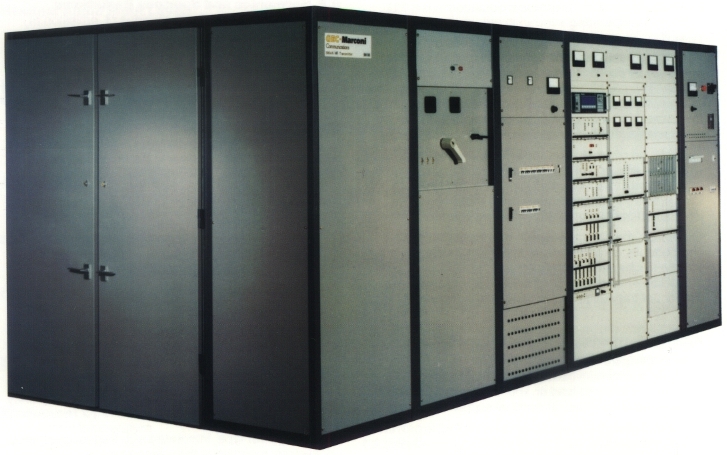| GENERAL DESCRIPTION |
 BENEFITS
BENEFITS| TECHNICAL SPECIFICATIONS | ||
| Power Output | 500kW minimum carrier power into a matched 50 ohm unbalanced load or, with external balun, a 300 ohm balanced load, at nominal supply voltage. Automatic adjustment of output coupling is provided to maintain full power into a VSWR not exceeding 2:1 for a 50 ohm load, or 1.8:1 for a 300 ohm load. Automatic reduction of power output to approximately 50% occurs for load VSWR of greater than 2:1. |
|
| Type of Transmission | Amplitude modulation, d.s.b. (ITU Classification A3E). or Amplitude modulation, double sideband with programme controlled carrier (ITU X3E) or Single sideband, with -6dB or -12dB carrier reduction (ITU R3E) |
|
| Modulation | High level anode and screen modulation using an all solid state modulator SSB modulation is by the Envelope Elimination and restoration method (EER) |
|
| Carrier Shift | Less than 5% amplitude between 0 and 95% modulation measured at 400 Hz with constant mains voltage. | |
| R.F. Harmonics and Spurious Radiations | The mean power of any spurious r.f. emission at frequencies up to 40 MHz when working into a matched test load will not exceed a value of -70 dB relative to the unmodulated carrier. For harmonics and spurii above 40 MHz the level will be -80 dB relative to the unmodulated carrier. |
|
| Operating Frequencies | Frequencies within the range 3.90 MHz to 26.1 MHz. Full performance applies to the broadcast bands defined by WARC-1979 & WARC-92 as follows: | |
| 3.90 - 4.00MHz* 4.75 - 5.06MHz* 5.90 - 6.20MHz 7.10 - 7.35MHz 9.40 - 9.90MHz 11.60 - 12.10MHz |
13.57 - 13.87MHz 15.10 - 15.80MHz 17.48 - 17.90MHz 18.90 - 19.02MHz 21.45 - 21.85MHz 25.60 - 26.10MHz |
|
| * These frequency ranges are with the optional low frequency extension kit. | ||
| Time For Frequency Change | Typically 12 seconds for a change to a previously used frequency. The transmitter internal memory will hold up to 4000 previously used frequency settings. Typical 20 seconds for a change to a new frequency. |
|
| Drive | Synthesiser type, integrated with frequency change system, mounted in the transmitter. The drive may be demounted and installed in a central area, or capable of frequency selection from a remote point. Internal frequency reference normally supplied but external 1 MHz standard providing a level of 0.45 to 2.5V r.m.s. into 50 ohms can be used if required. |
|
| Frequency Stability |
|
|
| Audio Input Impedance | 600 ohms balanced (nominal). | |
| Audio Input Level Control | 19.5 dB in 0.5 dB steps by front panel controls. | |
| Nominal Audio Input Level | With the front panel control set at centre position, a preset attenuator allows 40% modulation to be obtained from a 400 Hz tone at any level from -5dBm to +l0dBm | |
| Audio Frequency Response | ±1 dB between 50 Hz and 6000 Hz +1,-2 dB between 6000 and 7500 Hz relative to 400 Hz when transmitter modulated to 75%. |
|
| Audio Frequency Harmonic Distortion | 2.5% at 50% modulation and 4% at 90% modulation between audio frequencies of 50 Hz and 7500 Hz. | |
| Noise and Residual Modulation | At least 56 dB below the level corresponding to 100% modulation by a sine wave signal at 400 Hz. | |
| Output Monitoring | R.F. at approximately 10 to 16V peak carrier into 50 ohms unbalanced. In operation, this feeds the envelope monitor. A demodulated output provides OdBm ±3dBm (adjustable) into a 600 ohms balanced load at 100% modulation. |
|
| Equipment Operating Conditions | Ambient temperature Maximum Daily average Maximum Yearly average Maximum Humidity Maximum Altitude |
2°C to 50°C 45°C 35°C 95% 2300m (approx. 7500 ft) |
| Transmitter Rating | 100% sine wave modulation for 10 minutes per hour, followed by 70% modulation for 50 minutes per hour or 75% sine wave modulation continuously. |
|
| Incoming Power Supply | Auxiliary circuits: 380 volts or 415 volts, 3 phase, 4 wire, 50 Hz. Equipment for 60 Hz can be supplied to order. Main H.T. supply: Arranged to suit customer's supply. Voltages below 2.4kV not recommended. |
|
| Variation of Supply Voltage | Auxiliary circuits : ±10% (higher variations to special order) Main H.T. Supply: The transformer is provided with taps in order to compensate for the difference between the normal supply voltage to the transmitter, where this differs from the nominal voltage. Having selected the correct tap setting the transmitter will remain operational throughout short-term supply voltage variations of ±6% with respect to normal value. In additional full performance (except power output) will be maintained with variations of ±2% of nominal value. |
|
| Variation of Supply Frequency | ±4% reference nominal frequency. | |
| Overall Power Factor of Equipment | Better than 0.9 | |
| Overall Efficiency | The measured efficiencies between 3.95 and 25.6 ate typically between 75 and 80%. A carrier shift of 2.5% amplitude at 100% is assumed. Quoted efficiency is based upon power consumption when including all auxiliary power for the transmitter, cabinet air cooling and water circulating pump for an installation with a maximum ambient temperature of 30°C at sea level. |
|
| Specifications may change without notice | ||
| TUBE COMPLEMENT | |||
| RF stages | AF stages and modulator | ||
| Number | Type | Number | Type |
| 1 | TH576 | ||
| 1 | 4CW10,000A | ||
| THIS TYPE OF TRANSMITTER IS INSTALLED IN THE FOLLOWING COUNTRIES | |||||
| ITU | Country | ITU | Country | ||
| EGY | EGYPT | CLN | SRI LANKA | ||